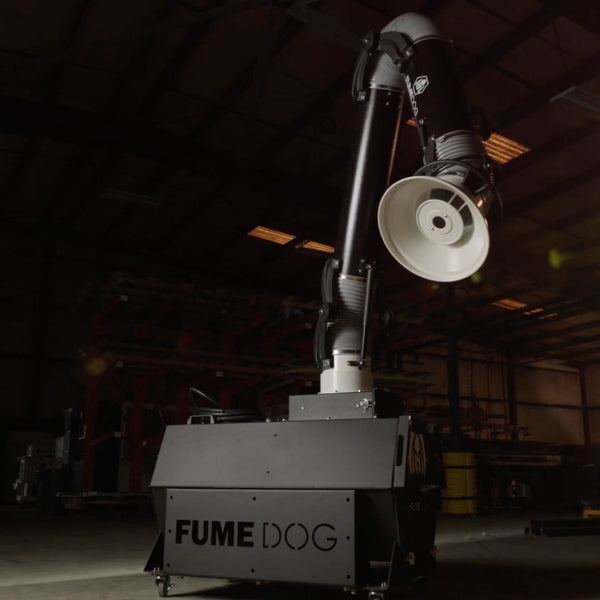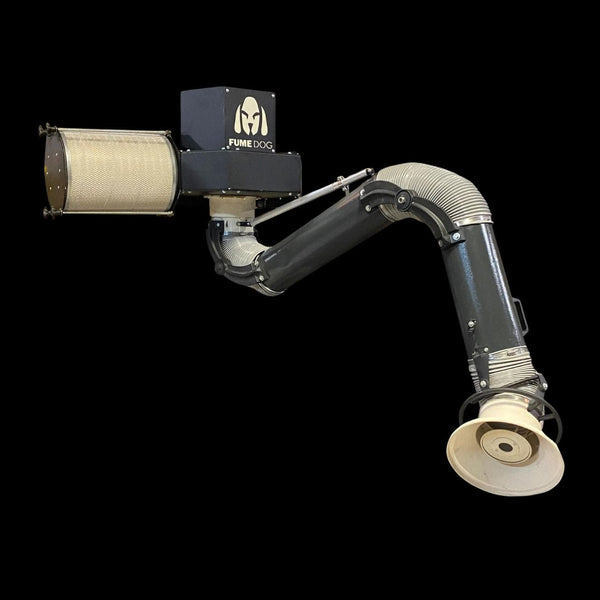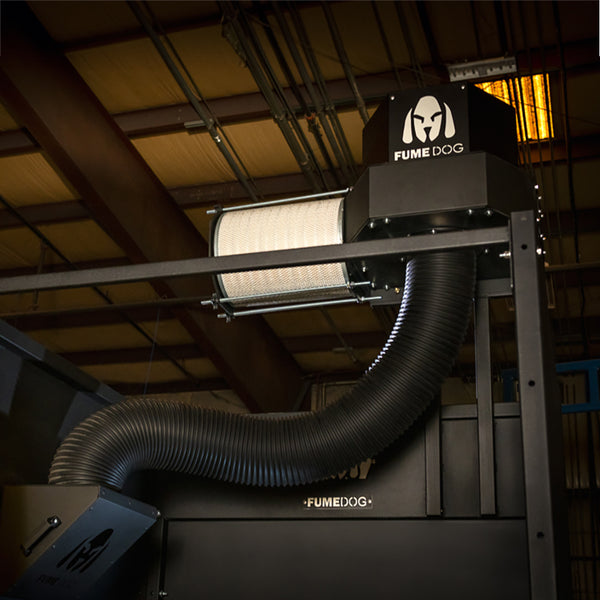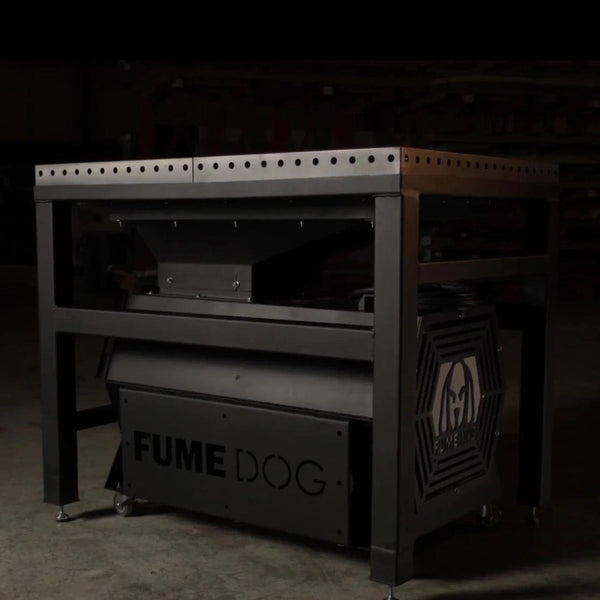Perhaps you’re already an apprentice welder, or maybe you’re just starting to think about entering this desirable career path; either way, you’ve no doubt come across the term “MIG welding”. It’s one of the most common and efficient welding methods used today, so it’s going to be pretty useful to learn about it.
If you’re finding it a bit overwhelming, don’t worry, as this guide explains the MIG welding process step-by-step, as well as what makes it so important and what equipment you’ll need to get started. Keep reading to learn how it works and why Fume Dog helps keep your workspace safe!
What Is MIG Welding?
MIG welding stands for metal inert gas welding. Essentially, this process uses a continuous wire electrode fed through a welding gun to join metals. An inert shielding gas, such as argon or carbon dioxide, protects the weld pool from air contamination.
This method creates clean welds quickly and works well on various materials like stainless steel and aluminum. In particular, MIG welding is ideal for industrial applications due to its efficiency and consistent results.
How MIG Welding Works
As we previously mentioned, MIG welding uses heat to join metals with precision. The process combines an electrode wire and shielding gas to create strong welds. Let’s break down the steps of MIG welding a little further to help you better understand it.
The Role of the Electrode and Shielding Gas
When you are doing MIG welding, the electrode wire passes through the welding torch to form the weld. It acts as both the filler metal and an electrical conductor, melting onto the base material. This melted metal creates a strong weld bead that joins pieces together.
Shielding gas is an important part of the process as it protects the molten pool from exposure to air contamination. Popular gases like argon and carbon dioxide help prevent oxidation, ensuring clean welding on stainless steel or other metals. Remember: the type of shielding gas greatly impacts arc stability and the overall quality of MIG welds.
The Welding Process Step-by-Step
To start MIG welding, you’ll first need to set up the welding machine and connect the wire feed system. The welder feeds a consumable wire electrode through the torch while releasing shielding gas to protect the molten metal from contamination. This process helps melt and fuse metals together effectively.
Then, it will be necessary to adjust settings like voltage and travel speed based on your material type, whether it’s stainless steel or aluminum. Hold the torch at a steady angle and maintain proper distance for even heat distribution. Most importantly, while welding, watch for consistent fusion and avoid spatter or defects in the finished joint.
Key Equipment Used in MIG Welding
MIG welding requires various tools for smooth operation. Each piece plays a crucial role in ensuring quality welds. Let’s take a look.
MIG Welding Machine
It should go without saying that, to start MIG welding, you’ll first need a MIG welding machine, which uses a spool-fed wire electrode to join metals like steel or aluminum. It continuously feeds the electrode and melts it with an electric arc, forming a strong bond between materials. It’s a process that combines precision and efficiency, making it perfect for various metal fabrication projects.
As we explained earlier, metal inert gas (MIG) welders use shielding gas to protect the weld from contamination caused by air exposure. This means you’ll need common gases such as argon or CO2.
Overall, these MIG welding machines are seriously versatile and suitable for beginners as well as professionals working on automotive repairs, construction projects, or heavy fabrication tasks.
Wire Feed System and Torch
You’ll certainly need a wire feed system when MIG welding, as it controls the flow of consumable electrode wire during MIG welding. It provides a steady and accurate supply to ensure consistent weld quality on materials like stainless steel or other metals. The system uses rollers to push the electrode wire through a flexible conduit leading to the torch.
The wire feed system should be paired with a torch, which delivers both shielding gas and electrode wire directly to the weld area. The shielding gas, often metal inert gas (MIG) or metal active gas, protects the molten metal from contamination. Don’t neglect to keep the torch well-maintained because this is crucial for minimizing downtime and ensuring clean, efficient welds in industrial applications.
Protective Gear and Accessories
Last but certainly not least, welders need to wear the following protective gear to avoid injuries and long-term health problems:
-
Welding helmet: Typically paired with an auto-darkening filter, a welding helmet protects your eyes from bright arcs and harmful UV rays.
-
Durable gloves: These important safety accessories shield your hands from burns, sparks, and heat.
-
Flame-resistant jackets or aprons: As with gloves, this protective gear offers safety against molten metal splatter.
-
Proper ventilation systems: Usually coming in the form of a fume extractor, ventilation systems help reduce exposure to dangerous fumes during MIG welding or flux-cored arc welding tasks.
-
Steel-toed boots: As you might expect, these protect your feet from dropped tools or heavy materials.
-
Earplugs: Finally, don’t forget to wear earplugs, as they safeguard your hearing in noisy settings.
Types of MIG Welding Techniques
As with any other type of welding, you’ll need to use various techniques to become proficient in MIG welding, each of which suits different materials and project needs. Here are the most common examples.
Short Circuit Transfer
Short circuit transfer is a MIG welding technique that operates at low voltage and current. The welding wire contacts the metal, forming a short circuit that melts the wire into tiny droplets. This method offers better control for thinner materials like stainless steel. It’s ideal for welding in positions requiring precision, such as vertical or overhead tasks, and works well with MIG welders and shielding gases to minimize spatter and enhance results.
Globular Transfer
In MIG welding, globular transfer happens when the weld wire melts and forms large droplets. These droplets fall to the base metal due to gravity instead of being guided by an arc. You’ll have to be careful, as this method creates high heat and spatter, which makes cleanup more difficult.
Generally, it works better with thicker metals, as it has challenges with thinner materials like stainless steel. Furthermore, the uneven droplet formation can make it harder to control the weld pool compared to other methods. Thankfully, using proper shielding gas, such as carbon dioxide or a mix, should help stabilize this process during flux-cored arc welding or MIG welding.
Spray and Pulsed Spray Transfer
Finally, the spray transfer technique uses a steady, fine mist of molten metal droplets that travel to the weld. This technique works best for welding stainless steel and thicker materials. It requires higher voltage and current settings but delivers deep penetration and a smooth, clean finish.
In contrast, pulsed spray transfer alternates between high-current bursts and low-current cycles, a process that lowers heat input while still creating strong welds. It’s especially useful for vertical or overhead positions where heat control is crucial.
Common Applications of MIG Welding
Before we finish up, it will be helpful to familiarize yourself with the most common applications of MIG welding so that you know when to use it. The process creates strong, clean welds for various industries, so professionals use it to handle all sorts of projects that require precision and durability.
Automotive Repairs
Metal inert gas (MIG) welding is essential for automotive repairs. It works well for fixing thin sheets of metal used in car bodies, as it allows for precise welds without distorting the material. Technicians might use it to repair exhaust systems, fix rusted areas, or join panels smoothly, as the combination of shielding gas and a steady electrode feed ensures strong and clean bonds efficiently.
Construction and Fabrication
Construction and fabrication often depend on metal inert gas (MIG) welding. Why? Well, the process creates strong, precise welds on metals like steel or aluminum, so workers in these industries use MIG welding to quickly assemble beams, frames, and components.
The technique boosts efficiency with a continuous wire feed system. It cuts down the time spent on repairs or manual adjustments during large projects. Automotive frames, structural supports, and custom fabrications benefit from this reliable method of joining metals.
Conclusion
Overall, you should now understand that MIG welding is a highly versatile and efficient method for joining metals. It uses an electrode wire and shielding gas to create strong, clean welds, commonly used in auto repairs and fabrication projects. There’s no denying that it can be dangerous, but that’s why we at Fume Dog are here to help. We ensure safe welding by offering top-notch fume extraction solutions.
Stay protected while you work with our reliable products!
FAQs
What is MIG welding, and how does it work?
MIG welding, also known as gas metal arc welding, is a popular welding method that uses a continuously fed wire electrode and shielding gas. An electric arc melts the wire and base metal, creating a strong joint as the metals solidify into a weld pool.
What’s the difference between MIG welding and TIG welding?
MIG welding is generally faster and easier, ideal for beginners or quick jobs. TIG welding, however, offers greater precision and control, making it preferable for intricate or delicate work.
Is MIG welding suitable for beginners?
Absolutely! MIG welding is often recommended for beginners because it's easy to learn, user-friendly, and produces clean, strong welds with minimal experience.
What materials can I weld using the MIG welding process?
The welding process used in MIG welding is versatile enough for various materials, including mild steel, stainless steel, and aluminum, making it perfect for diverse applications.
How important is ventilation or using equipment to filter metal fumes during MIG welding?
Proper ventilation is crucial during MIG welding to protect your health. Welding produces metal fumes that can be hazardous, so using specialized equipment designed to filter metal fumes ensures a safer, cleaner working environment.
What are the key advantages of choosing MIG welding?
MIG welding provides several benefits: it's fast, easy to control, produces minimal spatter, and delivers strong, clean welds—ideal for both professional and hobbyist welders.





